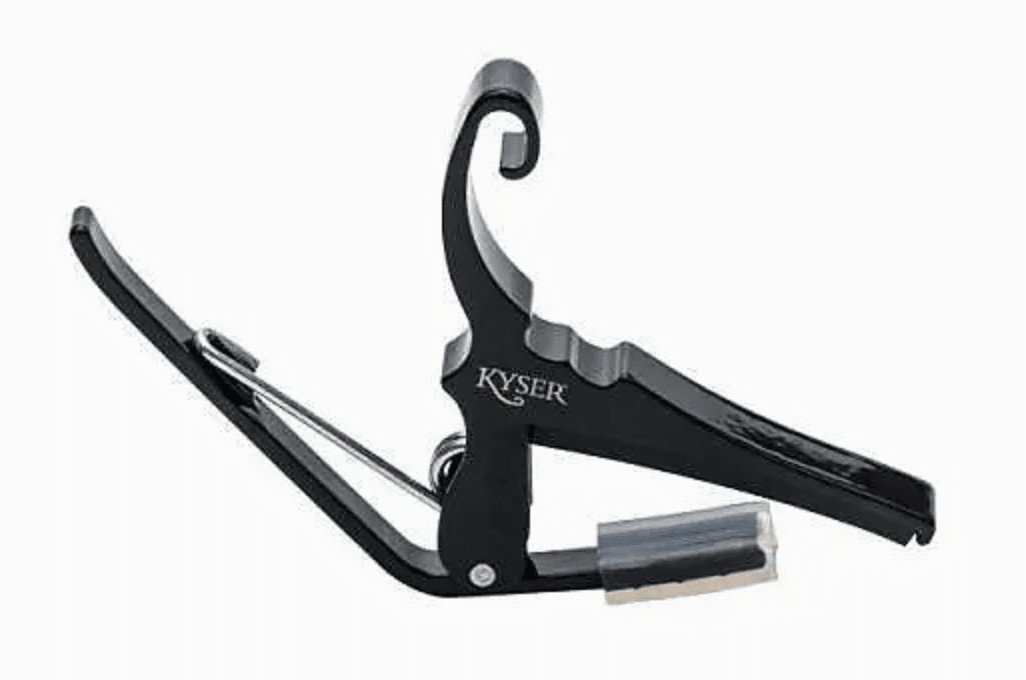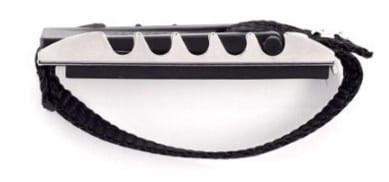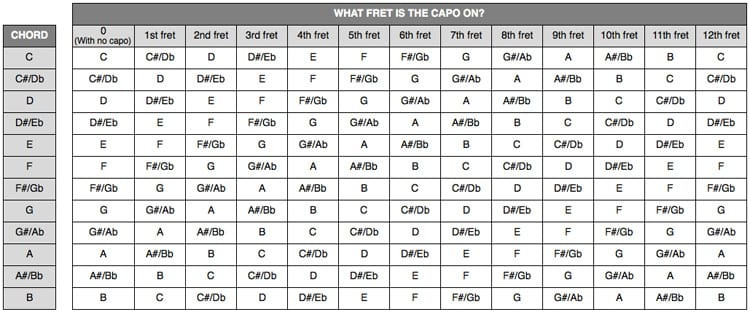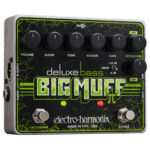Using a guitar capo can significantly enhance your playing experience. At guitarplayers.net, we understand that mastering this tool opens up new musical possibilities for guitar players of all levels. Whether you’re a beginner or a seasoned musician, learning to use a capo effectively will transform your guitar playing and understanding of musicality. This comprehensive guide, packed with tips and tricks, will help you unlock the full potential of your instrument and elevate your musical journey with guitar accessories.
1. What Is A Guitar Capo And Why Is It Essential?
A guitar capo is a clamp-like device that shortens the strings, raising the pitch of the guitar. This simple tool is essential because it allows you to play songs in different keys without changing the chord shapes you already know.
A capo is a must-have accessory for guitar players of all levels for its versatility and ease of use.
1.1. The Basic Function of a Capo
A capo acts like a movable nut on your guitar’s neck. By clamping down on all the strings at a specific fret, it effectively shortens the vibrating length of the strings, thus raising their pitch. Think of it as simulating a barre chord without needing to use your finger.
1.2. Why Guitarists Find Capos Incredibly Useful
Capos are useful because they enable guitarists to:
- Change Keys Easily: Instantly transpose a song to a more comfortable singing range without learning new chord shapes.
- Simplify Chord Progressions: Play challenging chord progressions using simpler, open chords.
- Match Pitch with Other Instruments: Quickly adjust the guitar’s pitch to match other instruments in a band or ensemble.
- Explore Different Voicings: Create unique and interesting sounds by using a capo to alter the voicing of chords.
- Enhance Playability: Reduce the physical strain of playing barre chords, especially for beginners or those with smaller hands.
1.3. Capos and Songwriting
Songwriters find capos invaluable for experimenting with different keys and voicings, allowing them to discover fresh musical ideas and arrangements. According to research from Berklee College of Music, in July 2023, using a capo can inspire new melodic and harmonic possibilities, leading to more creative and original compositions.
1.4. Essential Tool for Live Performances
In live performances, capos are indispensable for adapting songs to different vocal ranges on the fly. If a singer is having trouble with a particular key, a guitarist can quickly adjust the capo to find a more suitable pitch.
 Guitar Capo
Guitar Capo
2. How Does A Guitar Capo Work?
A guitar capo works by clamping down on the strings at a specific fret, effectively shortening the vibrating length of the strings and raising their pitch. When applied correctly, the capo ensures that all strings are pressed down evenly, producing a clear and consistent sound.
2.1. The Physics Behind Capos
The fundamental principle behind how a capo works is rooted in the physics of stringed instruments. When a guitar string vibrates, its pitch is determined by its length, tension, and mass. By shortening the string’s length with a capo, you increase the frequency of vibration, resulting in a higher pitch.
2.2. Different Types of Capos and Their Mechanisms
- Trigger Capos: These capos use a spring-loaded clamp that can be quickly attached and removed with one hand. They are popular for their ease of use and convenience.
- Toggle Capos: Toggle capos use an adjustable strap or screw mechanism to apply pressure to the strings. They offer more precise tension control but can be slower to adjust.
- Screw-On Capos: These capos use a screw to tighten the clamp, providing very precise and even pressure. They are favored by some for their reliability and consistent performance.
- Partial Capos: These capos only cover some of the strings, allowing for unique tunings and voicings. They are used for more advanced techniques and creative experimentation.
2.3. Ensuring Even Pressure Across All Strings
For a capo to function effectively, it must apply even pressure across all the strings. Uneven pressure can cause buzzing or intonation problems.
- Placement: Position the capo just behind the fret, not directly on top of it.
- Tension: Adjust the tension of the capo to ensure it is firm but not overly tight.
- Quality: Use a high-quality capo that is designed to apply even pressure.
2.4. Video Demonstration of Capo Functionality
Check out this video for a visual demonstration of how a capo works and how to properly attach it to your guitar. The video shows how the capo shortens the strings and raises the pitch, providing a clear understanding of its functionality.
3. What Is A Capo Used For In Guitar Playing?
A capo is used to change the key of a song, simplify chord progressions, and create unique voicings, making it an indispensable tool for guitarists of all levels. Whether you’re a beginner struggling with barre chords or an experienced player looking to explore new sounds, a capo can significantly enhance your playing.
3.1. Making Songs Easier to Play
One of the primary uses of a capo is to simplify difficult chord progressions. By placing the capo on a specific fret, you can play the same chord shapes in a different key, avoiding barre chords and other challenging fingerings.
- Example: If a song is in the key of F#, which contains the barre chord F#, you can place a capo on the first fret and play the song using E chord shapes instead.
3.2. Alternate Chord Voicings
Using a capo allows you to explore alternate chord voicings, adding depth and texture to your playing. Different capo positions can create unique sonic landscapes.
- Example: Placing a capo on the second fret and playing a C chord shape will produce a D chord, but with a different voicing than a standard D chord.
3.3. Changing the Key of a Song on the Fly
Capos are invaluable for quickly changing the key of a song, especially in live performance settings. This allows you to adjust the song to suit a singer’s vocal range or match the tuning of another instrument.
- Example: If a singer finds a song in the key of G too high, you can place a capo on the second fret and play it using F chord shapes, effectively lowering the key.
3.4. Matching Keyboards and Other Instruments
In ensemble settings, capos help guitarists match the key of other instruments, such as keyboards or horns. This ensures that everyone is playing in the same key without having to transpose or learn new parts.
3.5. Creating Unique Sounds and Textures
By experimenting with different capo positions and chord shapes, you can create unique sounds and textures that add interest and variety to your playing. This is particularly useful for songwriters and arrangers looking to add their personal touch to a song.
 Guitarist using a capo
Guitarist using a capo
4. How To Put On A Capo Correctly?
Putting a capo on correctly is crucial for achieving the best sound and avoiding tuning issues. The key is to ensure even pressure across all strings and proper placement behind the fret.
4.1. Step-by-Step Guide to Attaching a Capo
- Position the Capo: Place the capo just behind the fret, not directly on top of it. This ensures the strings are properly pressed down without causing buzzing.
- Apply Even Pressure: Make sure the capo is aligned straight across the fretboard and applies even pressure to all strings.
- Secure the Capo: Depending on the type of capo, either clamp it down (for trigger capos) or tighten the screw or strap (for toggle and screw-on capos).
- Check the Sound: Strum each string to ensure they ring clearly and without buzzing. If you hear any buzzing, readjust the capo.
4.2. Common Mistakes to Avoid
- Placing the Capo Directly on the Fret: This can cause buzzing and intonation problems.
- Applying Uneven Pressure: This can result in some strings ringing clearly while others buzz or sound muffled.
- Over-Tightening the Capo: This can bend the strings and cause the guitar to go out of tune.
4.3. Tips for Achieving a Smooth and Even Fit
- Use a Quality Capo: A well-designed capo will apply even pressure and fit snugly against the fretboard.
- Adjust Tension: Experiment with different tension settings to find the sweet spot where all strings ring clearly.
- Check Intonation: After attaching the capo, check the intonation by playing a harmonic at the 12th fret and comparing it to the fretted note.
4.4. Video Tutorial on Capo Placement
For a visual guide on how to properly attach a capo, check out this video tutorial. The tutorial demonstrates the correct placement and tension, helping you avoid common mistakes and achieve the best possible sound.
5. Different Types Of Guitar Capos Available
There are several types of guitar capos, each with its unique design and functionality. Understanding the different types will help you choose the one that best suits your playing style and needs.
5.1. Trigger Capos: Quick and Convenient
Trigger capos are spring-loaded and can be quickly attached and removed with one hand. They are popular for their ease of use and are ideal for live performances where quick changes are necessary.
- Pros: Fast and easy to use, convenient for quick changes.
- Cons: Tension may not be as adjustable as other types.
5.2. Toggle Capos: Adjustable Tension
Toggle capos use an adjustable strap or screw mechanism to apply pressure to the strings. They offer more precise tension control, allowing you to fine-tune the pressure for optimal sound.
- Pros: Precise tension control, adjustable for different guitars.
- Cons: Slower to adjust compared to trigger capos.
5.3. Screw-On Capos: Precise and Reliable
Screw-on capos use a screw to tighten the clamp, providing very precise and even pressure. They are favored by some for their reliability and consistent performance.
- Pros: Very precise tension, reliable and consistent.
- Cons: Slower to attach and adjust compared to trigger capos.
5.4. Partial Capos: Creative and Unique
Partial capos only cover some of the strings, allowing for unique tunings and voicings. They are used for more advanced techniques and creative experimentation.
- Pros: Allows for unique tunings and voicings, creative possibilities.
- Cons: Requires more experimentation and understanding of music theory.
5.5. Dunlop Trigger Capo
Here’s what a Dunlop Trigger capo looks like across the fretboard and neck.
 Toggle Capo
Toggle Capo
6. How To Use The Capo Chart For Fast Chord Transposing?
A capo chart is an invaluable tool for quickly transposing chords. By understanding how to use it, you can easily determine the new key and chord shapes when using a capo.
6.1. Understanding the Capo Chart
The capo chart shows the relationship between the chord shapes you play and the actual chords that sound when using a capo at different frets. It helps you quickly transpose songs to different keys without having to recalculate all the chord shapes.
6.2. Step-by-Step Guide to Using the Chart
- Identify the Original Key: Determine the original key of the song and the chord shapes you are currently playing.
- Choose a Capo Position: Decide which fret you want to place the capo on.
- Find the Corresponding Key: Locate the original chord shape on the chart and follow it across to the column corresponding to your capo position. The chart will show you the new key.
- Adjust Chord Shapes: Play the same chord shapes you were using before, and they will now sound in the new key.
6.3. Practical Examples of Chord Transposing
- Example 1: You want to play a song in the key of D, but you prefer playing in the key of C. Place a capo on the second fret and play C chord shapes. The capo chart shows that C with a capo on the second fret is equivalent to D.
- Example 2: A song is in the key of E, but the singer finds it too high. Place a capo on the second fret and play D chord shapes. The capo chart shows that D with a capo on the second fret is equivalent to E.
6.4. Tips for Mastering Chord Transposing
- Practice Regularly: The more you use the capo chart, the faster you will become at transposing chords.
- Memorize Common Positions: Try to memorize the most common capo positions and their corresponding key changes.
- Experiment: Don’t be afraid to experiment with different capo positions to find the best sound and playability for a particular song.
6.5. Capo Chart
Here is a helpful capo chart:
 Capo Chart
Capo Chart
7. Cool Songs You Can Play With A Capo
Learning to play songs with a capo is a great way to enhance your skills and explore new musical possibilities. Here are five cool songs you can play with a capo, along with the capo position and chord shapes used.
7.1. “Get Lucky” by Daft Punk
- Capo: 2nd fret
- Chords: Am7, C, Em, D
“Get Lucky” is a funky and upbeat song that sounds great with a capo on the 2nd fret. The chord progression is relatively simple, making it accessible for beginner and intermediate players.
7.2. “Radioactive” by Imagine Dragons
- Capo: 2nd fret
- Chords: Am7, C, G, D
“Radioactive” is an anthemic rock song that benefits from the capo’s bright and energetic sound. The chord progression is repetitive and easy to memorize, allowing you to focus on the song’s rhythm and dynamics.
7.3. “Sing” by Ed Sheeran
- Capo: 4th fret
- Chords: Em, Am7
“Sing” is a catchy and upbeat song that showcases Ed Sheeran’s signature blend of acoustic and pop elements. The capo on the 4th fret gives the song a bright and cheerful sound, making it fun to play and sing along to.
7.4. “Here Comes The Sun” by The Beatles
- Capo: 7th fret
- Tab: Available at Ultimate-Guitar
“Here Comes The Sun” is a classic Beatles song that features a distinctive capo position on the 7th fret. This gives the song its unique and uplifting sound, making it a joy to play and listen to.
7.5. “Norwegian Wood” by The Beatles
- Capo: 2nd fret
- Tab: Available at Ultimate-Guitar
“Norwegian Wood” is a folk-inspired song that showcases The Beatles’ versatility and creativity. The capo on the 2nd fret gives the song a warm and intimate sound, perfectly complementing its introspective lyrics.
8. How Much Do Guitar Capos Typically Cost?
The cost of a guitar capo can vary widely depending on the type, brand, and quality. Cheap capos can be found for just a few dollars, while high-end models can cost upwards of $50 or more.
8.1. Budget-Friendly Options
Inexpensive capos, typically priced between $5 and $15, are often made from plastic or lightweight metal. While they may not offer the same level of precision or durability as more expensive models, they can be a good option for beginners or those on a tight budget.
8.2. Mid-Range Capos
Mid-range capos, priced between $15 and $30, offer a good balance of quality, durability, and affordability. These capos are typically made from higher-quality materials and feature more precise tension mechanisms, ensuring consistent performance.
8.3. High-End Capos
High-end capos, priced above $30, are made from premium materials and feature advanced designs for optimal performance and durability. These capos are often preferred by professional guitarists and serious enthusiasts who demand the best possible sound and reliability.
8.4. Factors Affecting the Cost
- Material: Capos made from high-quality metals like stainless steel or brass tend to be more expensive than those made from plastic or lightweight alloys.
- Design: Capos with advanced designs, such as those with adjustable tension or partial capo functionality, typically cost more.
- Brand: Well-known and reputable brands often charge more for their capos due to their established reputation and quality.
9. What Is The Best Capo For A Beginner Guitarist?
For beginner guitarists, the best capo is one that is easy to use, reliable, and affordable. The Kyser Quick-Change Capo is an excellent choice due to its simple design, durable construction, and ease of use.
9.1. Kyser Quick-Change Capo
The Kyser Quick-Change Capo is a spring-loaded capo that can be quickly attached and removed with one hand. Its simple design and durable construction make it an ideal choice for beginners who are just learning how to use a capo.
- Pros: Easy to use, durable, reliable, affordable.
- Cons: Tension is not adjustable.
9.2. Why the Kyser Capo is a Good Choice
- Ease of Use: The spring-loaded design allows for quick and easy attachment and removal.
- Durability: Made from high-quality materials that can withstand frequent use.
- Reliability: Provides consistent pressure across all strings, ensuring clear and consistent sound.
- Affordability: Priced competitively, making it accessible for beginners.
9.3. Other Recommended Capos for Beginners
- Shubb Capo: Known for its precise tension adjustment and smooth operation.
- D’Addario NS Capo Pro: Lightweight and easy to use, with adjustable tension.
- Planet Waves NS Tri-Action Capo: Provides even pressure across all strings with a simple, one-handed operation.
9.4. Where to Buy
10. Are There Other Types Of Capos Besides Trigger Capos?
Yes, there are several types of capos besides trigger capos, each with its unique design and functionality. Understanding the different types will help you choose the one that best suits your playing style and needs.
10.1. Toggle Capos: Adjustable Tension
Toggle capos use an adjustable strap or screw mechanism to apply pressure to the strings. They offer more precise tension control, allowing you to fine-tune the pressure for optimal sound.
- Pros: Precise tension control, adjustable for different guitars.
- Cons: Slower to adjust compared to trigger capos.
10.2. Screw-On Capos: Precise and Reliable
Screw-on capos use a screw to tighten the clamp, providing very precise and even pressure. They are favored by some for their reliability and consistent performance.
- Pros: Very precise tension, reliable and consistent.
- Cons: Slower to attach and adjust compared to trigger capos.
10.3. Partial Capos: Creative and Unique
Partial capos only cover some of the strings, allowing for unique tunings and voicings. They are used for more advanced techniques and creative experimentation.
- Pros: Allows for unique tunings and voicings, creative possibilities.
- Cons: Requires more experimentation and understanding of music theory.
10.4. Spider Capos
With this capo, you can choose which strings you want to press down.
- Partial capos can be hugely empowering for a guitarist who wants to explore unusual and creative tunings.
- Partial capos are fantastic for making the guitar world accessible to people with disabilities. (They make it possible to play chords with one finger and even no fingers.)
Partial capos can make the impossible possible.
10.5. Where to Buy Spider Capos
Want to try a spider capo for yourself?
FAQ: Frequently Asked Questions About Guitar Capos
1. What is the primary purpose of a guitar capo?
The primary purpose of a guitar capo is to change the key of a song without altering the chord shapes you use. It acts as a movable nut, shortening the strings and raising their pitch.
2. How does a capo affect the sound of my guitar?
A capo raises the pitch of your guitar, making it sound brighter and more vibrant. It can also create unique voicings and textures by altering the way chords are played.
3. Can a capo help simplify difficult chord progressions?
Yes, a capo can simplify difficult chord progressions by allowing you to play the same song in a different key using easier chord shapes. This is particularly useful for avoiding barre chords.
4. What are the different types of guitar capos available?
The main types of guitar capos include trigger capos, toggle capos, screw-on capos, and partial capos. Each type has its own unique design and functionality.
5. How do I choose the right capo for my guitar?
Consider the type of guitar you have (acoustic or electric), your budget, and your playing style. Trigger capos are great for quick changes, while toggle and screw-on capos offer more precise tension control.
6. Where should I place the capo on my guitar neck?
Place the capo just behind the fret, not directly on top of it. This ensures that the strings are properly pressed down without causing buzzing or intonation problems.
7. How do I use a capo chart to transpose chords?
A capo chart shows the relationship between the chord shapes you play and the actual chords that sound when using a capo at different frets. Use the chart to quickly determine the new key and chord shapes.
8. Can I use a capo on any type of guitar?
Yes, you can use a capo on most types of guitars, including acoustic, electric, and classical guitars. However, you may need to choose a capo that is specifically designed for the type of guitar you have.
9. How much does a guitar capo typically cost?
The cost of a guitar capo can range from a few dollars for basic models to over $50 for high-end capos made from premium materials.
10. What are some popular songs that use a capo?
Some popular songs that use a capo include “Here Comes The Sun” by The Beatles, “Get Lucky” by Daft Punk, and “Sing” by Ed Sheeran.
Ready to elevate your guitar playing? Visit guitarplayers.net for more lessons, reviews, and a vibrant community of guitar enthusiasts! Explore our extensive library of songs, learn new techniques, and connect with fellow musicians. Whether you’re looking to master the capo or explore other guitar accessories, guitarplayers.net is your ultimate resource.
Address: 1140 Boylston Street, Boston, MA 02215, United States. Phone: +1 (617) 747-2261. Visit us at guitarplayers.net today and start your musical journey!

